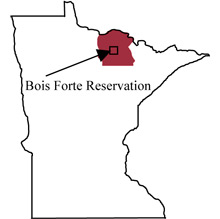1866 Treaty with the Chippewa – Bois Forte Band
Signed April 7, 1866 in Washington, D. C.
In 1854 the Bois Forte Band of Ojibwe, as parties to an enormous land cession in present-day Minnesota and Wisconsin, identified an area that included Lake Vermillion as territory. Twelve years later, the Commissioner of Indian Affairs reported to Congress that
“… discoveries of gold have been made in that region, and the attention of whites was turned to the country, and several expeditions were fitted out for its exploration. The Indians became alarmed and excited on account of this invasion of their country, and the probability of collision between the parties made it desirable that an attempt should be made to obtain peaceable possession of the country”
Gold mining companies had been incorporated in Minnesota months prior to the treaty, and an armed contingent of miners had moved to Lake Vermillion in December of 1865. More than 3,000 acres were staked out using claims based on scrip issued to mixed-blood Ojibwe through earlier treaties, a commodity that quadrupled in price in a single day. Speculative mining companies were quickly formed, attracting capital from throughout the U.S. “One of the most secure, both financially and politically,” according to historian David Walker, was the Minnesota Gold Mining Company, headed by president Henry Sibley, which rapidly sold $5,000,000 in shares.
The “Minnesota Gold Rush” was short-lived, however, because the State geologist had incorrectly identified magnetic pyrite as gold. By 1867, only about 70 white people remained in the ceded territory. Today, the Bois Forte Reservation is founded on land identified and retained in the 1866 treaty.










